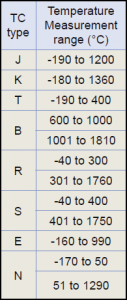“One of the best kept secrets in the instrumentation world is that sub-zero thermocouple measurements require thermocouples that are specially qualified for that application.”
Looking at the specs of a typical thermocouple data acquisition system might be a little misleading when it comes to interpreting temperature measurement capability. For example Figure 1 is a snap-shot of the thermocouple measurement range for our model DI-245 voltage, mV, and thermocouple data acquisition system taken directly from the product’s data sheet. If you believe that measurements of sub-zero temperatures can be accomplished using almost any thermocouple type as implied by the table, you can be forgiven. One of the best kept secrets in the instrumentation world is that sub-zero thermocouple measurements require thermocouples that are specially qualified for that application.
The Sub-zero Thermocouple Measurement Problem
By “sub-zero” I mean any temperature measurement that is less 0 °C. It is generally not possible for thermocouple manufacturers to provide alloys that operate both above and below zero in the same thermocouple wire. And since the vast majority of thermocouple applications are for measurements above zero, that’s where the bulk of thermocouples are guaranteed to operate. Thermocouples for the substantially fewer sub-zero applications must be ordered specifically for that purpose. So, although instruments are designed to make the sub-zero measurements the weak link is the thermocouple itself, especially if it has not been specifically designed for such use. Unfortunately, the danger is that an unqualified thermocouple gives the appearance of working below zero but is actually generating large measurement errors. Likewise, a thermocouple that is qualified for sub-zero work may generate large errors above zero. So, if you make measurements both above and below zero, be sure to have a procedure in place that identifies one thermocouple qualification from the other.
Thermocouple Types for Sub-zero Work
Should you need to perform sub-zero work, generally certified type E and T thermocouples are used in that application. Other thermocouple types exhibit poor characteristics, like becoming brittle, succumbing to corrosion, or generating an exceedingly low EMF at cryogenic temperatures.
Any reputable thermocouple supplier should be able to provide pricing and availability for thermocouples that are certified for sub-zero work. If that’s what you need, be sure to convey so at the time of your order to ensure accurate measurements using our products or anyone else’s.


 View Cart
View Cart sales@dataq.com
sales@dataq.com 330-668-1444
330-668-1444